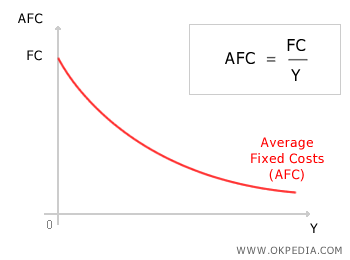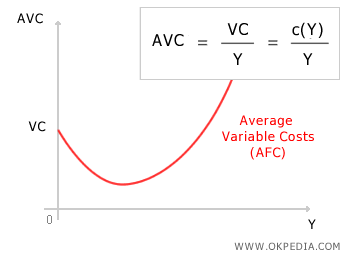Average Cost
Average cost refers to the per-unit cost of production. It is calculated as the total cost (C) of production divided by the number of units produced (Y). Essentially, it tells us how much, on average, it costs to produce a single unit.
The Average Cost Formula
The formula for average cost AC, or unit cost, is expressed as follows:

Total cost (C) includes both fixed and variable costs. It is the sum of fixed costs (FC) and total variable costs (VC):
C = FC + VC
By breaking total cost (C) down into its fixed (FC) and variable (VC) components, we can rewrite the average cost (AC) formula as:

This breakdown allows us to analyze average cost in greater detail. The first term, FC / Y, represents the average fixed cost, while the second term, CV / Y, represents the average variable cost.
- Average Fixed Costs. Average fixed costs (AFC) decline as production increases because fixed costs (FC) are spread over a larger number of units (FC / Y). As output rises, AFC approaches zero. This is because an increase in production (ΔY) only affects variable costs (ΔVC), while fixed costs remain unchanged.

- Average Variable Costs. Average variable costs (AVC) follow the behavior of total variable costs (VC). Initially, as output (Y) increases, marginal productivity is rising, so production expands more than proportionally relative to the additional variable costs incurred (ΔVC). This leads to falling average variable costs. However, beyond a certain point, diminishing marginal returns take effect, reversing this trend—AVC starts increasing as production continues to grow, leading to the typical U-shape of the average cost curve.

The Average Cost Curve
Adding the average fixed cost (AFC) and the average variable cost (AVC) at each level of production (Y) gives us the average cost curve (AC), also known as the unit cost curve.

Graphically, average cost can be plotted on a standard Cartesian diagram, with average cost (AC) on the vertical axis and production quantity (Y) on the horizontal axis. Below, the average cost curve (red) is shown alongside the marginal cost curve (brown).

Why Is the Average Cost Curve U-Shaped?
The average cost curve takes on a U-shape due to two key effects: in the early stages of production, fixed costs dominate total costs (driving average cost down), but as output expands beyond a certain point, diminishing marginal returns cause variable costs to rise, pushing average cost back up.
- Declining Phase of the Average Cost Curve. Initially, the average cost curve slopes downward because total cost includes fixed costs (e.g., facilities, equipment). Fixed costs remain constant regardless of production volume, so as output increases, these costs are distributed over a larger number of units, lowering the average cost (AC). During this phase, both average fixed costs and average variable costs decrease due to increasing marginal productivity.
- Technical Optimum (Minimum Average Cost). The lowest point on the average cost curve represents the technical optimum, where production is at its most efficient. At this point, the firm is operating at its optimal capacity, making the best use of its resources. The marginal cost (MC) curve intersects the average cost curve precisely at this minimum. This is often called the shutdown point because the firm cannot sustain production if the market price falls below this level. If the selling price were lower than this minimum cost, the firm would incur losses and eventually be forced to exit the market. However, the technical optimum does not necessarily align with the economic optimum (see the difference between technical and economic efficiency).
- Rising Phase of the Average Cost Curve. As production expands beyond its optimal level, the average cost curve begins to slope upward. This occurs because output growth exceeds the efficient balance between input usage and production capacity. With a fixed production facility, increasing input usage beyond a certain threshold reduces efficiency, driving up variable costs (VC). As a result, the average cost (AC) rises. In this phase, rising average variable costs outweigh the continued decline in average fixed costs.
 Difference Between Average Cost and Marginal Cost. Average cost and marginal cost measure different things. Average cost is the total cost divided by the quantity produced, while marginal cost represents the additional cost of producing one more unit. Unlike average cost, which includes both fixed and variable costs, marginal cost only accounts for variable costs, since fixed costs do not change with production volume. As shown in the graph, the marginal cost curve initially lies below the average cost curve. Average cost declines more gradually due to the presence of fixed costs (FC), while marginal cost falls more sharply since it only reflects variable costs (VC). The marginal cost curve intersects the average cost curve at its minimum point. As production increases, marginal costs rise more steeply due to diminishing marginal returns, while average costs increase at a slower rate due to the continued spreading of fixed costs (CUF) over a larger output.
Difference Between Average Cost and Marginal Cost. Average cost and marginal cost measure different things. Average cost is the total cost divided by the quantity produced, while marginal cost represents the additional cost of producing one more unit. Unlike average cost, which includes both fixed and variable costs, marginal cost only accounts for variable costs, since fixed costs do not change with production volume. As shown in the graph, the marginal cost curve initially lies below the average cost curve. Average cost declines more gradually due to the presence of fixed costs (FC), while marginal cost falls more sharply since it only reflects variable costs (VC). The marginal cost curve intersects the average cost curve at its minimum point. As production increases, marginal costs rise more steeply due to diminishing marginal returns, while average costs increase at a slower rate due to the continued spreading of fixed costs (CUF) over a larger output.
 Short-Run Analysis. Average cost is typically analyzed in the short run, where fixed costs remain unchanged and production capacity is fixed. Even if a firm decides to expand, new investments take time to materialize and do not immediately affect current production capacity. In the short run, firms can only increase output by using more variable inputs (raising variable costs) while keeping fixed costs constant.
Short-Run Analysis. Average cost is typically analyzed in the short run, where fixed costs remain unchanged and production capacity is fixed. Even if a firm decides to expand, new investments take time to materialize and do not immediately affect current production capacity. In the short run, firms can only increase output by using more variable inputs (raising variable costs) while keeping fixed costs constant.
